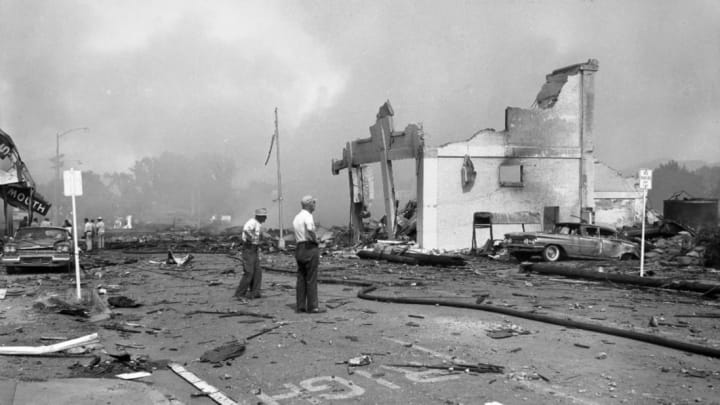As horrific as last week’s fertilizer plant explosion in West, Texas, was, it’s (sadly) not without precedent. Ammonium nitrate, the explosive compound that caused the catastrophe, is often used in fertilizer because of its high nitrogen content. It’s also super soil-soluble, so it’s extremely effective at seeping down to the roots of plants. The other reason it’s typically mass-produced is for munitions, especially during wars. Because the stuff is so volatile, it’s been the source of more than a few tragedies over the years.
1. The Roseburg Blast, 1959
Truck driver George Rutherford parked his truck in front of the Garretsen Building Supply Company in downtown Roseburg, Oregon, on the night of August 6, 1959. He then retreated to the nearby Umpqua Hotel to get some rest before his morning delivery. The delivery never happened, because sometime between midnight and 1 a.m., the Garretsen Building Supply Company caught on fire. Shortly thereafter, the fire ignited the contents of Rutherford’s truck—two tons of dynamite and 4.5 tons of ammonium nitrate. All of the buildings in an eight-block radius were totally destroyed (pictured above) and 14 people died. Rutherford survived.
2. Morgan Depot Explosion, 1918
As the largest producer of ammunition during WWI, the T.A. Gillespie Shell Loading Plant in Sayreville, N.J., produced 32,000 shells a day. The plant exploded on October 4, 1918, scattering debris—including thousands of shells—over a 1.25-mile radius from the plant. At least 100 people were killed in the fires and explosions that raged on for three days afterward. As recently as 2007, an unexploded shell was found in a schoolyard during an excavation for a new playground.
A local historian believes the explosion was likely caused by worker error, but for nearly 100 years, townspeople have wondered if the Germans somehow found a way to sabotage the plant.
3. The Oppau Explosion, 1921
A German silo storing 4500 tons of fertilizer, a mix of ammonium nitrate and ammonium sulfate, was at the heart of this 1921 catastrophe that leveled hundreds of houses, killed 561 people, and devastated a small town.
The combination of the two compounds proved to be disastrous. Together, they formed a plaster-like substance that workers had to chip apart with pickaxes, or blast apart with blasting powder. Though both sound like a terrible idea, workers had successfully used the blasting powder more than 16,000 times without incident at this particular location. However, this exact technique is what caused the explosion of two ammonium nitrate-loaded rail cars in Germany just two months earlier.
Despite the size of this tragedy, it could have been worse - only 450 of the 4,500 tons of fertilizer actually detonated.
4. The Great Explosion, 1916
In April 1916, some empty sacks caught fire at a building in Uplees, about 60 miles southeast of London. While this would normally be a rather uneventful thing, the sacks happened to be located at the Explosives Loading Company, a factory that filled bombs and shells. The fire spread and ignited 15 tons of TNT and 150 tons of ammonium nitrate, killing 116, including the entire fire brigade. The victims were buried in a mass grave.
5. Nixon Nitration Works Disaster, 1924
The Nixon Nitration Works in Raritan Township, known these days as Edison, N.J., produced nitrocellulose, a flammable plastic that was used to make film and x-rays, among other things. The Nitration Works leased one of their buildings to the Ammonite Company, which used it to take apart artillery shells so their contents could be reused as fertilizer. That meant that more than 1 million gallons of ammonium nitrate was being stored about 300 feet away from the highly flammable nitrocellulose.
We still don’t know exactly what caused the explosion, even after an inquiry by the U.S. Secretary of War. Ammonite blamed Nixon and Nixon blamed Ammonite. Whatever happened, the resulting blast rattled windows in Staten Island, nearly 20 miles away. Eighteen people were killed, two were reported missing, and 100 were injured.
6. The Texas City Disaster, 1947
Nearly 600 people were killed and thousands were injured when a freighter being loaded with 2300 tons of ammonium nitrate exploded in Texas City on April 16, 1947. The 1.5-ton anchor of the ship was found two miles away. The first explosion was so powerful that it registered as an earthquake in Denver, 900 miles away.
To make matters worse, the first blast made a nearby Monsanto chemical storage facility explode as well, killing 234 of the 574 workers. You can see the explosion at about 2:20 in the video below.
7. The Ryongchon Disaster, 2004
Ryongchŏn, a North Korean town about 12 miles from China, was the site of a massive explosion in April 2004. At least one train carrying mining explosives was involved in the accident, but—surprise—North Korea was incredibly secretive about what happened, so we don’t know much else. The country actually cut their phone lines to the rest of the world almost immediately after the incident. Surprisingly, though, North Korea allowed the Red Cross to come in and help with disaster relief. According to the Red Cross, 160 people were killed, 1850 buildings were destroyed, and another 6350 were damaged.
Because Kim Jong-il had passed through the same train station just a few hours prior to the explosion, some speculated that it had been a failed assassination attempt. No evidence was ever found to support this, but the supreme leader may have actually been the indirect cause of the tragedy: one theory is that two trains collided because the train timetable changes due to Kim Jong-il’s visit weren’t communicated to all parties.
